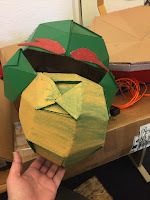The two new media artists that I
found particularly interesting were Porpentine and Emilie Gervais. Propentine is an artist who considers herself
to be a trash woman and creates video games as well as interactive fiction that
is created through the text software Twine.
She is a transgender woman that currently lives in Oakland, CA, and has
included many forms of harassment and difficulties that are experienced by
transgendered people, such as abuse, escapism, and other forms of violence into
her works for she has been harassed and abused for the majority of her life and
was kicked out of her home by the age of 14 (Hudson).
In multiple interviews, Porpentine has described her work as something
like a diary and as a way of getting around her weaknesses because she puts so
much of her own experiences into her works, specifically these works of
interactive fiction. These works of
fiction and her other games focus on what society may think of as trash or is
worthless, so she often includes a lot of trash, slime, and sludge in her games
(Hudson). She is best known for her
work Howling Dogs in the gaming world and this work is a good example of how
one may feel like they are free when in fact they are very limited in what they
can do and where they can go.
Emilie Gervais is a freelancing
internet artist who currently lives in Marseille, France and explores the
correlation between art, network culture, and the internet. She has created multiple GIFs and websites
for other artists and her own projects. The way that she creates these GIFs are
rooted in the 90s by having an 8-bit look, but the content of her work is
not. These Gifs and her work are meant
to be interchangeable in a way so that the content can be changed in order to
view the different dynamics of life from different angles. She compares it to being more like what
sociologists do rather than a piece of performance art that created an approach
to different types of social dynamics from different points of view (Rourke). She believes that play is a structural
component of life, which then allows for the opening of space for
experimentation.
The piece of work that I really
loved of Porpentine’s is her 2014 interactive fiction game With Those We Love Alive, which tells the story of love in a world
that if rules by an Empress who is adored and reviled as she oppresses her
subjects. There is a main storyline to
follow in this game, but there are many details that can be controlled by the
player, such as the set up at the beginning of the game when the player is
asked to answer a few questions. For me,
the results, of my questions gave me the name of Casende Jandet. When playing this game, the player is brought
into this world created by Porpentine by giving them a unique name and having
them draw small images on their skin throughout the game. When Porpentine makes
you draw on your skin as you are playing the game she is beginning to blur the
lines between the digital and physical world.
These sigils that she makes you draw are what Porpentine sees as being a
part of love and by drawing them on the player’s skin, the game and love have
now left its mark on you. This game is
meant to show how love can be oppressed and expressed in a dangerous world as
well as how dangerous love itself can be as these two characters in this story
flee for their lives in an oppressed world.
The language that she uses in this game and her other pieces of fiction
is also very powerful and meaningful.
She gives just enough detail for you to begin to imagine the world you
are meant to be in and surrounded by, but there is also enough missing that you
can fill in some of the blanks on your own.
There is also preexisting music that is used in this game by Brenda
Neotenomie, who Porpentine came across when looking for music to add to the
game after finishing it. Porpentine
mentions in a video interview how she was glad that she was able to find this
music and how it fits so well in her game (Porpentine,
Sup Holmes? Ep 84 with Porpentine). The music used is more abstract and possibly
would be considered as that of electronic or techno music, yet it is able to
set the tone of what the player should be feeling at a particular point in the
game just like other more visual video games.
The most distinguished detail
that this story is based on Porpentine’s life is that when you enter this world
you enter the life of a transgender woman who is living in a strange and alien
world and is continuously mistreated and oppressed, just like Porpentine has
been treated all her life. There is no
dreaming in this world, but there is a dream distillery that seems to be under
construction for the first half of the game and when it does open the player
can go and take a sip of some sort of liquid that will make you feel better for
a little while. I feel that this is
meant to show that in a harsh reality, as most Trans people experience,
dreaming can only do so much before you have to come back to reality and face
life. Towards the end of this game it
also shows that you can chose to follow the crowd or stand alone and a part in
order to help yourself have a better life and be treated better, and the ending
of this game does suggest that you can get out of a terrible situation and make
things better for yourself.
Emilie Gervais’ collaborative piece
Blinking Girls is an “anticlimax movie
poster website for the Blinking Girls
happening” (Gervais) that was a part of Apache Project in 2012, and included a
series of artworks by Emilie Gervais and her collaborative partner Sarah Weis. This installation occurred as Mother Neff
State Park in Moody, Texas, in a cave that was once used by the Tonkawa Indians
as a shelter as well as a burial site, creating a lot of controversy over using
the site as an art installation. It
ended up happening in the form of a photoshoot in GIFs were displayed on
tablets, smartphones, and laptops that were placed in the cave and documented (Rourke). It was originally meant to be more of a
physical installation with actual bubble machines and light effects, but was
disapproved at the last minute and was even cut short when they were
documenting the installation that was actually put on. Due to the installation only lasting for a
short period of time and occurred once, it has been called a happening as well
as an installation with the official name being Blinking Girls Cave. The
girl used in the online poster is based on the character Tasha, as she is seen
blinking in the Leisure Suit Larry Land of the Lounge Lizards trailer from
1987. The text bubbles next to her are
meant to show that she is always open for business by saying “Come Inside.” Due to this being an online website movie
poster, only so much can be shown to entice people to come in, so the act of
blinking is used as a more sexual act that is meant to make you feel welcomed
and want to come in and see the show(Warren-Crow). Gervais and her collaborative project partner
Sarah Weis sat that through this use of blinking and what this image is taken
from, they are empowering women and embracing how they are typically seen
online, which is that of a gaming character.
The Blinking Girls Cave installation show the current collaborative work
by Gervais and Weis, but people could submit their own blinking images that may
“have to go through cosmetology treatment in order to ‘make the cut’”(Warren-Crow). Therefore, even though they are trying to
embrace something about the female figure, they are still willing to adhere to
society’s norms in the sense of how one should look and what is considered to
be beautiful in society.
These works are similar in the
sense that each artist is making a statement about some aspect of what comes
with being a woman, even a Trans woman in Porpentine’s case. They are embracing something that the world
doesn’t necessarily want to look or what is already being seen of the feminine
aspect. Each artist is also bringing technology into a physical space rather
than just showing these works online, which Gervais has done with some of her
work in which they were a part of a solely online gallery exhibition. I also noticed that the artists themselves
have a greater presence on social media, specifically tumblr and Twitter in
order to share news about their work and responses to previous work. The difference I found between these two
works and their artists is that one is based on more personal experiences that
are used in her work and the other is trying to embrace something that already
exists and is more accepted in society, even if some people may disagree with
it and its continued use in advertising when using a female figure.
In conclusion, I really enjoyed
researching these artists and their work, especially Porpentine’s work with her
interactive fiction. I read multiple reviews
for her game With Those We Love Alive,
and most mentioned how great and powerful is and I agree with most of these
comments. They also mentioned her use of
language in her writing and what drawing on your skin does to you as you play
this game, which I also completely agree with.
Emilie Gervais’ stuff was also interesting to look at and research
overall and how she used Blinking Girls
as a way of giving the installation an online presence as well as a physical
one.
Works Cited
Gervais, Emilie. Blinking Girls. n.d. 2016.
<http://emiliegervais.com/blinking-girls/>.
Hudson, Laura. Twine, the Video-Game Technology for All.
19 November 2014. December 2016. <https://www.nytimes.com/2014/11/23/magazine/twine-the-video-game-technology-for-all.html?_r=0>.
Mother Neff S.P, Blinking Girls happening. 2011. <apacheprojects.tumblr.com>.
Porpentine. n.d. <slimedaughter.com>.
Porpentine. Sup Holmes? Ep 84 with Porpentine
Destructoid. 19 November 2013.
<https://www.youtube.com/watch?v=9Mw7vWr9wyM>.
Rougeau, Michael. Making "With Those We Love
Alive," A Game That Leaves Its Mark On You. 4 December 2014. December
2016. <http://animalnewyork.com/2014/making-love-alive-game-leaves-mark/>.
Rourke, Daniel. Artist Profile: Emilie Gervais. 18
April 2013.
<https://rhizome.org/editorial/2013/apr/18/artist-profile-emilie-gervais/>.
Warren-Crow, Heather. Girlhood and the Plastic Image.
Dartmouth College Press, 2014.










































